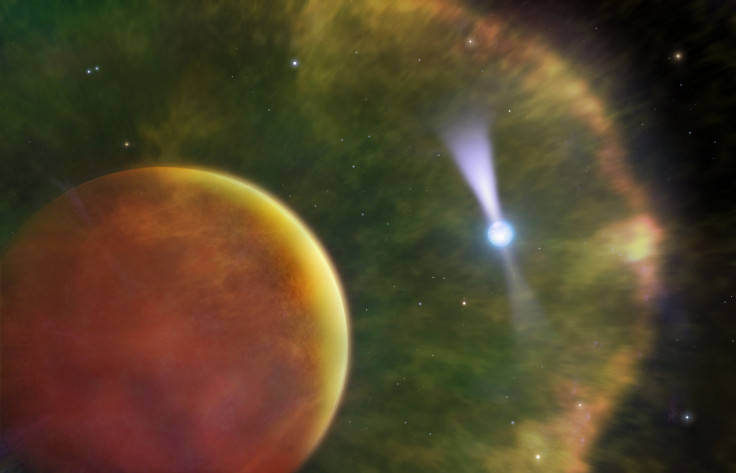Distant ‘Black Widow’ Pulsar Seen In Unprecedented Detail, Thanks To Stellar Companion

A group of astronomers has observed radiation zones on an exotic, rapidly spinning neutron star, aka a pulsar, sitting some 6,500 light years away from Earth in unprecedented detail.
The observation, which is one of the highest-resolution works in the history of astronomy, was made possible with the help of a cool, lightweight brown dwarf star orbiting just 2 million kilometers away from the pulsar, approximately five times the difference between the Earth and moon.
The pulsar, officially designated as PSR B1957+20, and the brown dwarf are orbiting each other — an engagement that makes up a binary star system, but the latter is also leaving behind a “wake” or a comet-like tail of gas. This wake is what the researchers used to peer into the pulsar, spinning more than 600 times a second, like never before.
According to a release from University of Toronto's Dunlap Institute for Astronomy & Astrophysics, the institute behind the latest work, the observation also helped the researchers observe two separate radiation zones on the pulsar. Essentially, as the pulsar spins, the two regions, separated by a distance of about 20 kilometers, act as hotspots and emit beams of radiation.
"The gas is acting as like a magnifying glass right in front of the pulsar," Robert Main, lead author of the study published in the journal Nature, said in a statement. "We are essentially looking at the pulsar through a naturally occurring magnifier which periodically allows us to see the two regions separately."
However, it is also worth noting that the radiation from this pulsar will also be the cause of demise for its companion brown dwarf. The cool star is about a third the diameter of the sun, but as it sits eerily close — completes a single orbit in nine hours — to the pulsar by cosmic standards, the intense radiation from the rapidly spinning companion is blasting the cool star on a regular basis. Plus, as the brown dwarf is tidally locked to the neutron star like the way moon is locked to Earth, one side of the star always faces the radiation blast, getting heated up to 6000 degrees Celsius or the temperature of our sun.
This way the pulsar will gradually erode gas from the dwarf star and consume it completely over a long period. Notably, this is also the reason why the pulsars involved in such systems are often compared with black widow spiders that eat their mate and dubbed “black widow” pulsars.
Among other things, the researchers note that the observations taken in the latest work could prove critical in understanding Fast Radio Bursts, aka FRBs — a high-energy astrophysical phenomenon of unknown origin.
"Many observed properties of FRBs could be explained if they are being amplified by plasma lenses," Main added in the statement. "The properties of the amplified pulses we detected in our study show a remarkable similarity to the bursts from the repeating FRB, suggesting that the repeating FRB may be lensed by plasma in its host galaxy."
© Copyright IBTimes 2024. All rights reserved.





















